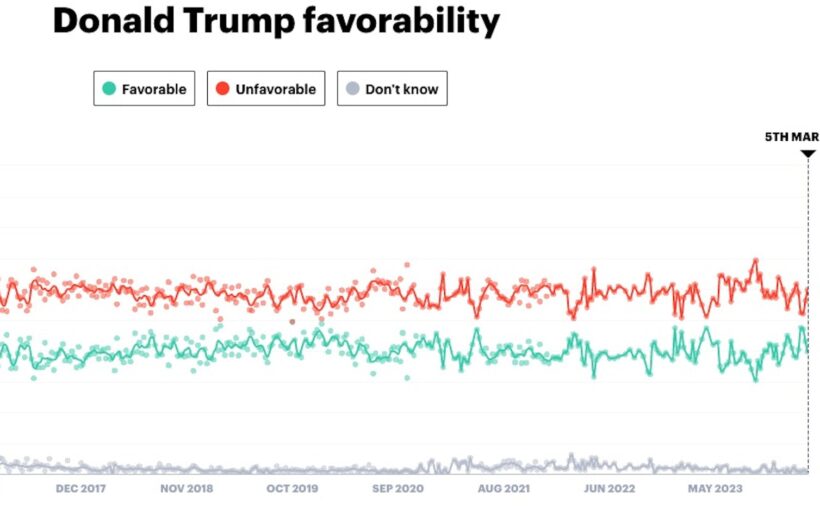The fight for votes in the upcoming US presidential election is likely to be particularly focused on suburbia.
Historically, Republicans win most support in rural areas and Democrats have larger vote shares in cities. But the suburbs have long been a political battleground.
Voters in these areas have swung in favour of candidates of both parties in recent elections, making them a key target for political advertising in 2024. But there are a few key factors that could make the suburban vote slightly different this year.
Both Donald Trump and Joe Biden have recorded electoral successes in suburban areas in past elections. In 2016, Trump outperformed Hillary Clinton in the suburbs, if only by a two-point margin (47-45). Just two years into his presidency, however, voting behaviour in the suburbs shifted away from Trump’s Republican party.
In the 2018 midterms, Democrats won the support of 52% of suburban voters while Republicans only received 45% of the vote. Biden was able to build on this momentum in 2020, with 54% of suburban residents casting their vote for the Biden-Harris ticket while Trump fell short of his 2016 result, receiving only 44% of the suburban vote in 2020.
Under Biden, the midterms also saw slight shifts in voting behaviour in the suburbs. In the 2022 midterms, Democrats received slightly less support in the suburbs than in 2020 and 2018, gaining just 50% of the vote. Republicans, on the other hand, recorded 48%, a slight upward trend from their 2018 and 2020 results in suburban counties.
Only 5% of 2018 Democratic voters swung Republican in 2022 and only 4% of 2018 Republican voters switched to supporting Democratic candidates in 2022.
Shifting political opinions may not be the only possible explanation for swing votes in suburban counties. According to data from Pew Research, voter turnout is a much larger issue for both parties, though more so for Democrats.
Among suburban voters who voted for Democratic candidates in 2018, 22% did not vote in the 2022 midterms. On the Republican side, 16% of 2018 suburban voters stayed home in 2022.
Another possible explanation for shifting voting patterns in the suburbs lies in who has moved there recently. The population of the large suburban counties has increased by 25% in the 21st century.
Overall, population growth in the suburbs has been above the national average. And since 2000, the US population has been increasingly concentrated in the 52 largest metropolitan areas, and particularly their suburban counties.
Who will win Haley’s supporters?
People living in the suburbs are now more likely, than in previous decades, to be college-educated, a demographic group that has been more likely to vote for Democratic candidates and hold more liberal political views.
Interestingly, it was this demographic group, college-educated voters, who made up a large share of Nikki Haley’s supporters during her Republican primary campaign. Many Republican women who backed Trump in 2016 and 2020 shifted to Haley in the 2024 primaries – arguing that Haley would be able to unify the party and bring about change while Trump could not deliver on either of those issues.
And while Trump outperformed Haley in most demographic groups throughout the primaries, college-educated women were the exception. As Trump and Biden compete for Haley’s voting bloc now, the place to find these voters may just be in the suburbs. And this is where college-educated residents now make up the largest share of the population.

Both candidates could face difficulties in suburbia, though. Throughout the primaries, gaining support from suburban voters has been one of Trump’s key weaknesses.
Currently, Biden is doing slightly better with the key suburban demographic groups than Trump. Among college-educated adults, Biden has a favorability rating of 46.6%, while Trump only records a 39.7% favorability rating (where people rank their feelings towards a politician as positive or negative).
However, the president may not do as well in smaller suburban counties where the population is less likely to be college-educated. Current polling shows that Trump does much better among people with education qualifications up to a high school diploma (56.7% favorability rating) than Biden (36%).
Trump’s suburban woman problem
However, Trump has not been doing as well in the suburbs during the primaries as pollsters had predicted. This has raised questions about the accuracy of polls and potential biases or blind spots.
Moving populations and changing demographics are also a potential explanation. There are other issues at stake in 2024 that may cause shifts in electoral behaviour and which could mean these voters are not wiling to reveal their intentions to pollsters.
One example of this is the issue of abortion rights. While some conservative voters have disclosed that they were supportive of abortion rights and were therefore not voting for Trump, there may be a significant number of women, particularly in more conservative neighbourhoods and states, who may be hesitant to disclose such shifts in voting intentions.
Haley did well among suburban women, particularly those who had concerns about Trump’s policies on family and health, wanted more focus on the economy and were not happy with the nastiness of the Trump campaign.
If the key to the White House is winning over Haley’s voters, as has been widely suggested since her exit from the race, this voting group may just be what Biden needs, a detail that has not gone unnoticed by his campaign.
![]()
Caroline Leicht does not work for, consult, own shares in or receive funding from any company or organisation that would benefit from this article, and has disclosed no relevant affiliations beyond their academic appointment.



